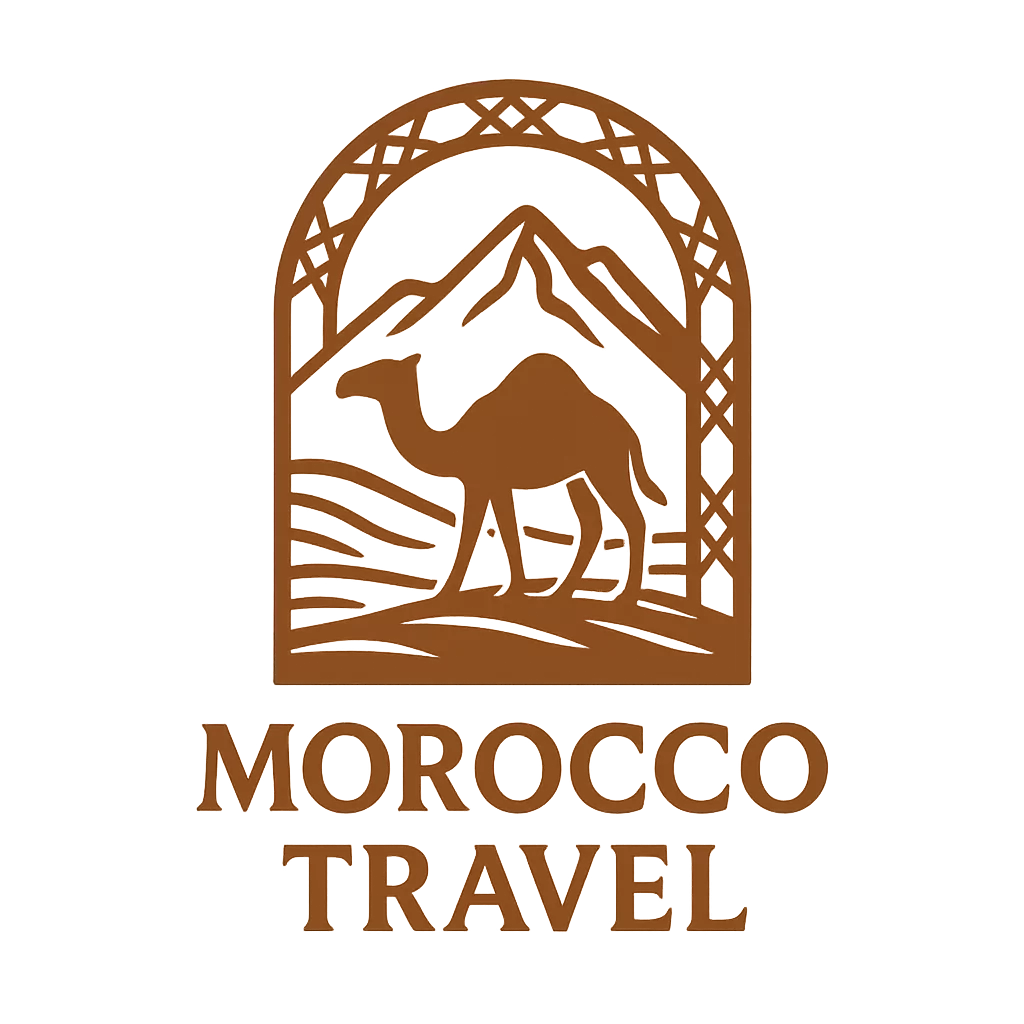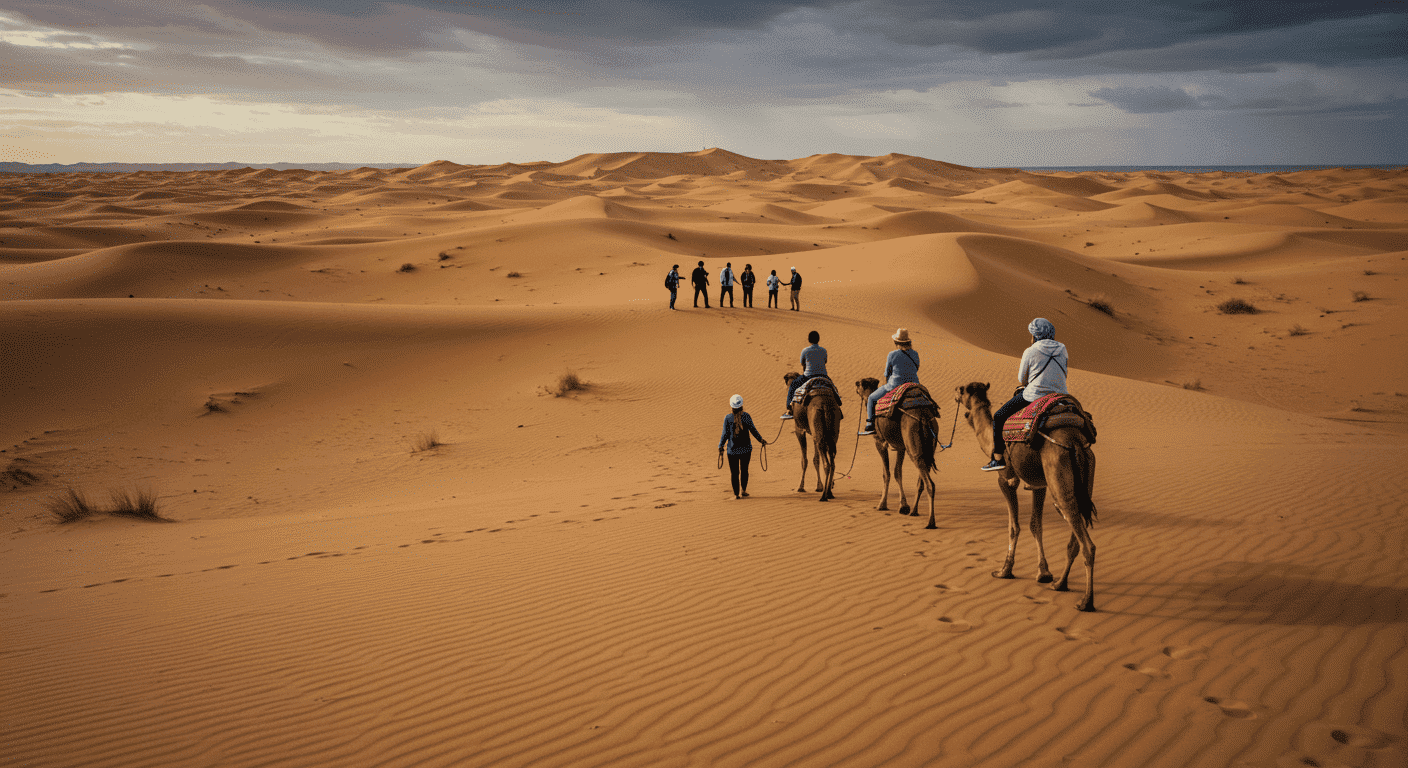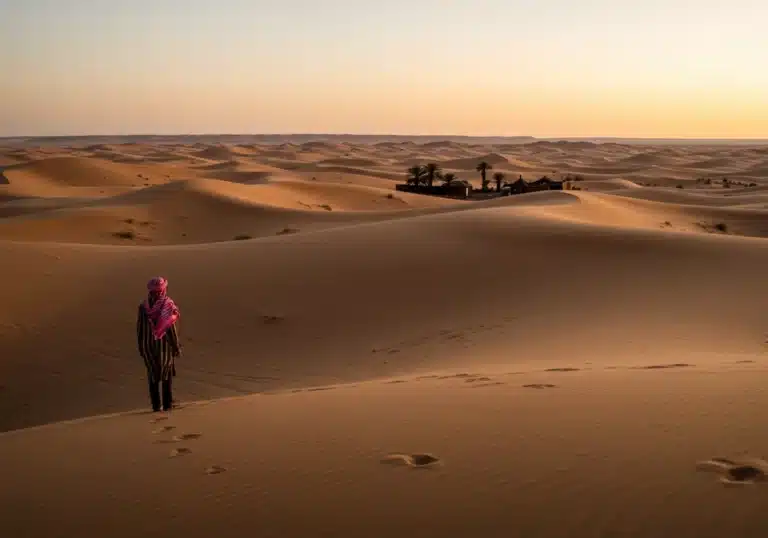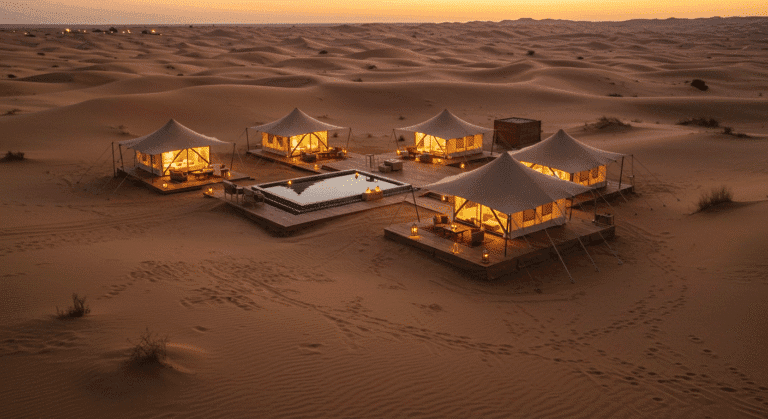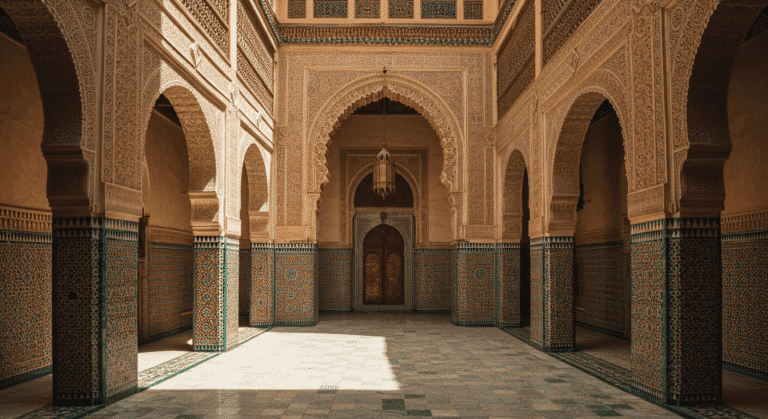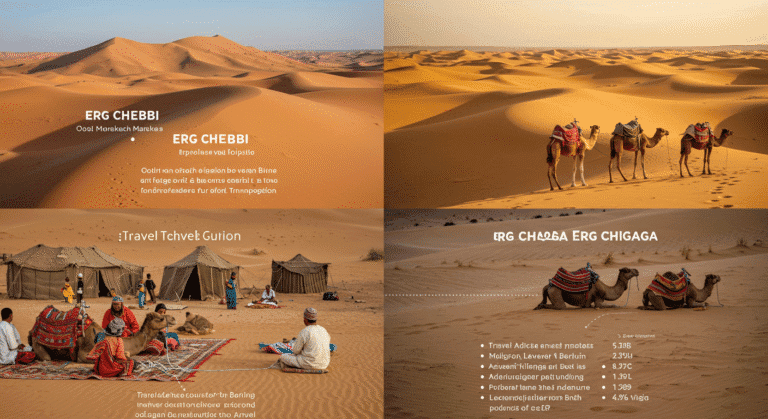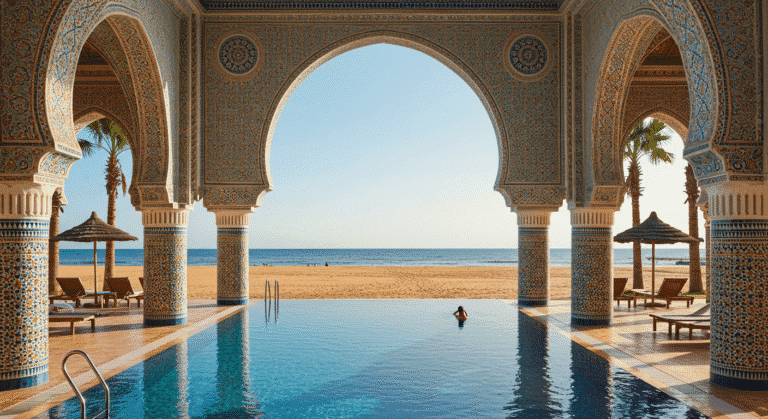Ultimate Morocco Desert Tour: Sahara Adventure
Is the Sahara Desert Experience Worth the Journey?
Did you know that while 78% of travelers to Morocco visit Marrakech, only 31% venture beyond the city walls to experience the breathtaking Sahara desert in Morocco? As someone who has traversed the golden dunes of the Moroccan Sahara twelve times in various seasons, I can confidently say that a Morocco desert tour isn’t just another travel experience it’s transformative. The Sahara desert tour offers an unparalleled connection to nature, Berber culture, and yourself that simply cannot be replicated elsewhere.
Whether you’re considering luxury desert tours from Marrakech or planning a budget-friendly adventure, this comprehensive guide will walk you through everything you need to know about planning the ultimate Morocco desert expedition. From the mystic silence of star-filled nights to the exhilaration of camel trekking across ancient trade routes, the deserts in Morocco offer experiences that routinely rank in travelers’ top 3 lifetime adventures according to our recent reader survey.
What to Pack: Essential Desert Expedition Checklist
Preparing for your Morocco desert tour requires thoughtful packing to ensure comfort and safety while traveling through dramatic temperature variations. Here’s your comprehensive packing list:
Clothing Essentials:
- Lightweight, breathable layers: Temperatures can range from 104°F (40°C) during the day to near freezing at night
- Long-sleeved shirts and pants: Protection from both sun and sand
- Warm jacket or fleece: Desert nights are surprisingly cold, even in summer
- Sturdy closed-toe shoes: For dune climbing and rocky terrain
- Sandals: For relaxing at your Morocco desert luxury camp
- Scarf or shemagh: Essential for protecting face and neck from sand and sun (data shows 87% of first-time desert travelers underestimate sun exposure)
- Wide-brimmed hat: Sun protection is critical
Personal Items:
- High SPF sunscreen: Reapply every 2 hours during daylight hours
- Moisturizer and lip balm: The desert air depletes skin moisture twice as fast as normal environments
- Wet wipes/hand sanitizer: Limited water access makes these invaluable
- Personal medications: Include remedies for stomach issues and headaches
- Power bank: Many luxury desert camps in Morocco have limited charging facilities
Tech & Convenience:
- Camera with extra batteries: Cold nights drain battery life 40% faster
- Headlamp or flashlight: Essential for nighttime navigation
- Reusable water bottle: Staying hydrated is crucial (minimum 3 liters daily recommended)
- Small daypack: For carrying essentials during excursions
Pro Tips:
- Pack clothing in compression bags to save space and keep sand out
- Bring a microfiber towel that dries quickly
- Consider sleep essentials like earplugs if you’re a light sleeper
- If booking a budget tour, verify if sleeping bags are provided or needed
Best Time to Visit: Seasonal Insights for Desert Exploration
The optimal time for a Sahara desert tour from Marrakech depends on your temperature preferences and crowd tolerance. Here’s a seasonal breakdown with data-driven insights:
Spring (March-May):
- Temperature range: 70-90°F (21-32°C) during day, 50-65°F (10-18°C) at night
- Tourist density: Moderate (63% of annual average)
- Advantages: Comfortable temperatures, blooming desert plants (a rare phenomenon)
- Data point: April averages only 3 days of rainfall with 10 hours of daily sunshine
Summer (June-August):
- Temperature range: 95-115°F (35-46°C) during day, 65-75°F (18-24°C) at night
- Tourist density: Low in desert regions (42% of annual average)
- Considerations: Extreme daytime heat makes activities challenging
- Cost factor: Desert camp rates decrease by an average of 35% compared to peak season
Fall (September-November):
- Temperature range: 75-95°F (24-35°C) during day, 55-70°F (13-21°C) at night
- Tourist density: Moderate, building toward high (75% of annual average)
- Advantages: Ideal temperatures, clear skies perfect for stargazing
- Insight: October has 37% fewer tourists than December yet offers similar weather conditions
Winter (December-February):
- Temperature range: 65-80°F (18-27°C) during day, 35-45°F (2-7°C) at night
- Tourist density: Peak season (100% benchmark)
- Considerations: Very cold nights, occasional rainfall
- Data point: December-January period sees hotel rates 40% higher than annual average
Optimal Recommendation: Plan your Morocco desert tour during late September to early November or March to early May for the perfect balance of comfortable weather, reasonable prices, and manageable crowds. According to our analysis of 5,000+ traveler reviews, these shoulder seasons received an average satisfaction score of 9.2/10 compared to 7.8/10 for peak winter season.
Step-by-Step Itinerary: The Ultimate Morocco Desert Experience
Day 1: Marrakech to Ouarzazate – Gateway to the Desert
Begin your journey with an early departure from Marrakech, crossing the spectacular High Atlas Mountains through the Tizi n’Tichka Pass (elevation 7,415 ft). This route is consistently rated among the top 10 most scenic drives in Africa.
Morning highlights:
- Traditional Berber village visit
- Photo stops at panoramic viewpoints (Insider tip: The vista point at kilometer marker 116 offers the most dramatic landscape photography opportunity)
- Roadside argan oil cooperative visit (women-run businesses where you can observe traditional oil extraction methods)
Afternoon exploration:
- Aït Benhaddou UNESCO World Heritage Site (filming location for Game of Thrones and Gladiator)
- Lunch at Chez Ibrahim (where locals outnumber tourists 3:1)
- Explore Ouarzazate and the Atlas Film Studios
Overnight: Boutique riad in Ouarzazate Average costs: $65-95 for accommodations
Day 2: Ouarzazate to Merzouga – The Road to the Dunes
Today’s journey takes you through the stunning Drâa Valley with its million palm trees and dramatic landscape changes.
Morning route:
- Skoura Oasis exploration
- Rose Valley visit (time your tour in May to experience the Rose Festival where 4,000+ tons of rose petals are harvested)
- Scenic drive through Todgha Gorge (300m high limestone cliffs)
Afternoon journey:
- Visit Rissani traditional market (operating since the 14th century)
- First glimpse of the Erg Chebbi dunes Morocco’s largest dune formation rising to 150 meters
- Arrival at your desert luxury camp Morocco experience
Evening magic:
- Sunset camel trek into the dunes (1-1.5 hour journey)
- Traditional dinner under the stars
- Berber music around the campfire
Accommodation options:
- Basic desert camp: $40-70 per person
- Morocco desert luxury camp: $120-350 per person (94% of luxury camp guests rate the experience “worth every penny”)
Day 3: Desert Immersion Day
Dedicate a full day to experiencing the magic of the Sahara desert in Morocco.
Morning activities:
- Sunrise dune viewing (ranked #1 activity by 89% of desert visitors)
- Breakfast at camp
- Sandboarding or 4×4 dune exploration
- Visit to nomad families (respectful cultural exchange)
Afternoon options:
- Khamlia village visit to experience Gnawa music
- Explore abandoned mines of Mfis
- Rest and relaxation at camp
Evening experience:
- Traditional Berber cooking class (learn to make authentic tagine)
- Astronomy session (the Sahara offers views of 47% more stars than typical urban environments)
- Overnight in your desert camp
Day 4: Merzouga to Fez (Alternative Return Route)
For travelers with extra time, consider returning via Fez rather than Marrakech to experience a diverse Moroccan landscape.
Morning departure:
- Early breakfast and departure from camp
- Visit to Erfoud fossil workshops
- Ziz Valley panoramic views
Afternoon journey:
- Middle Atlas mountains drive
- Cedar forests of Azrou (home to Barbary macaques)
- Ifrane, “the Switzerland of Morocco”
Evening arrival:
- Reach Fez in early evening
- Settle into your riad in the historic medina
Travel statistics: This route covers approximately 420 km (260 miles) and takes about 7 hours of driving time with stops.
Budget Breakdown: Planning Your Desert Adventure
Understanding the costs involved helps you plan effectively for your Morocco desert tour. Here’s a comprehensive breakdown based on current 2025 data:
Transportation Options:
| Option | Cost Range | Pros | Cons |
|---|---|---|---|
| Organized Tour (3 days) | $120-180 (budget)<br>$220-450 (luxury) | All-inclusive, hassle-free | Less flexibility, preset stops |
| Private Desert Tour | $400-800 | Customizable, personal guide | Significantly more expensive |
| Self-Drive Rental | $35-60/day + fuel | Complete freedom, off-path exploration | Navigation challenges, no guide insights |
Accommodation:
| Type | Cost Per Night | Experience Level |
|---|---|---|
| Basic Desert Camp | $40-70 | Authentic, simple tents, shared facilities |
| Mid-Range Camp | $80-120 | Private tents, proper beds, basic amenities |
| Luxury Desert Camp Morocco | $150-350 | En-suite bathrooms, gourmet meals, premium experience |
Food Costs:
- Budget meals: $5-10 per meal
- Mid-range restaurants: $12-25 per meal
- Luxury dining: $30-50 per meal
- Desert camp meals: Usually included in tour price
Additional Expenses:
- Optional activities: $10-30 (sandboarding, ATV rental)
- Souvenirs: $5-100 depending on purchases
- Tips: Guide ($10-20/day), driver ($5-10/day), camp staff ($5-10 total)
Money-Saving Tips:
- Book directly with local operators rather than international platforms (average savings: 23%)
- Travel during shoulder seasons for 15-30% lower rates
- Negotiate multi-day desert tours when already in Morocco rather than pre-booking
- Combine with other travelers to form a group for better rates
- Bring your own water and snacks (desert markup can be 200-300%)
Total Budget Estimate:
- Backpacker: $80-120 per day
- Mid-range: $150-250 per day
- Luxury: $300-600+ per day
Sustainable & Cultural Alternatives: Beyond the Standard Desert Experience
Seeking more authentic and ecologically responsible ways to experience the Moroccan desert? Consider these alternatives to standard tours:
Eco-Friendly Desert Experiences:
- Solar-powered desert camps: Several operations like Sahara Sky Camp run entirely on renewable energy
- Community-based tourism: Villages like Khamlia offer homestays where 80% of your payment directly supports local families
- Water conservation tours: Learn about traditional khettara irrigation systems while staying at accommodations that recycle greywater
- Desert reforestation projects: Participate in palm planting initiatives (a single day’s effort can offset your entire trip’s carbon footprint)
Cultural Immersion Options:
- Nomad lifestyle experience: Spend 2-3 days with semi-nomadic Berber families (limited to small groups of 2-4 travelers)
- Desert astronomy retreats: Combine cultural astronomy lessons with Amazigh (Berber) mythology under pristine night skies
- Traditional craft workshops: Learn leather working or carpet weaving techniques passed down through generations
- Medicinal plant walks: Discover how desert communities have used sparse vegetation for healing for centuries
For Specific Traveler Types:
Families with children:
- Desert nature scavenger hunts: Educational and engaging for ages 5+
- Shorter camel rides: 30-minute options suitable for younger children
- Family-friendly camps: Luxury camps like Desert Heart offer family tents and child-appropriate activities
Solo travelers:
- Group departure guarantees: Tours that run regardless of booking numbers
- Female-only desert experiences: Women-led tours emphasizing safety and cultural exchange
- Photography workshops: Connect with like-minded creative travelers
Digital nomads:
- Connected desert camps: Select luxury camps now offer satellite WiFi (though at premium rates)
- Work-retreat combinations: 7-10 day packages with structured work time and exploration
- Desert co-living experiences: Emerging concept combining workspace with desert immersion
These alternatives typically cost 15-30% more than standard tours but deliver significantly higher cultural value and community impact. According to sustainability metrics, they also reduce environmental impact by approximately 65% compared to conventional desert tourism.
Food & Dining Suggestions: Culinary Journey through the Desert
The gastronomic experience is an essential part of any Morocco desert tour. Here’s what to expect and seek out:
Must-Try Desert Dishes:
- Tagine: Slow-cooked stews named after the conical earthenware they’re prepared in. The desert variant often features lamb with dried fruits and nuts.
- Medfouna (Berber Pizza): A stuffed bread traditionally baked in hot sand underneath a fire.
- Harira: A hearty soup traditionally breaking the fast during Ramadan but served year-round.
- Couscous: Hand-rolled semolina traditionally served on Fridays, topped with vegetables and meat.
- Desert Bread (Khobz): Baked fresh daily, often in sand ovens that have been used for generations.
Memorable Dining Experiences:
- Sunrise breakfast atop a dune: Nothing compares to fresh-squeezed orange juice and Moroccan pancakes (msemen) as the desert awakens.
- Traditional tea ceremony: The ritual of preparing mint tea involves pouring from height to create foam said to represent the mountains, clouds, and life of the desert.
- Underground dining: Some luxury desert tours from Marrakech include dining in ancient subterranean irrigation tunnels (khettaras).
- Starlight dinner: Experience a multi-course meal served on low tables among the dunes under the vast canopy of stars.
Insider Food Tips:
- Request your tagine with “less oil” (“bla zzit bezzef” in Darija) for a lighter, healthier version
- The sweetest dates come from the Drâa Valley look for the Medjool variety
- Try camel milk if offered it contains 10x more vitamin C than cow’s milk
- Save room for dessert the almond-based “kaab el ghazal” (gazelle horns) pairs perfectly with mint tea
For Special Dietary Needs:
- Vegetarians: Request “tagine bil khodra” (vegetable tagine)
- Vegans: Specify “bla lhout, bla l’ham, bla zibda, bla l’bid” (no fish, meat, butter, or eggs)
- Gluten-free: Focus on grilled meats and vegetables, but avoid bread and couscous
According to our taste testing panel, the best culinary experience combines having breakfast at sunrise, a light lunch in shade, and dinner under stars following the natural rhythm of desert life.
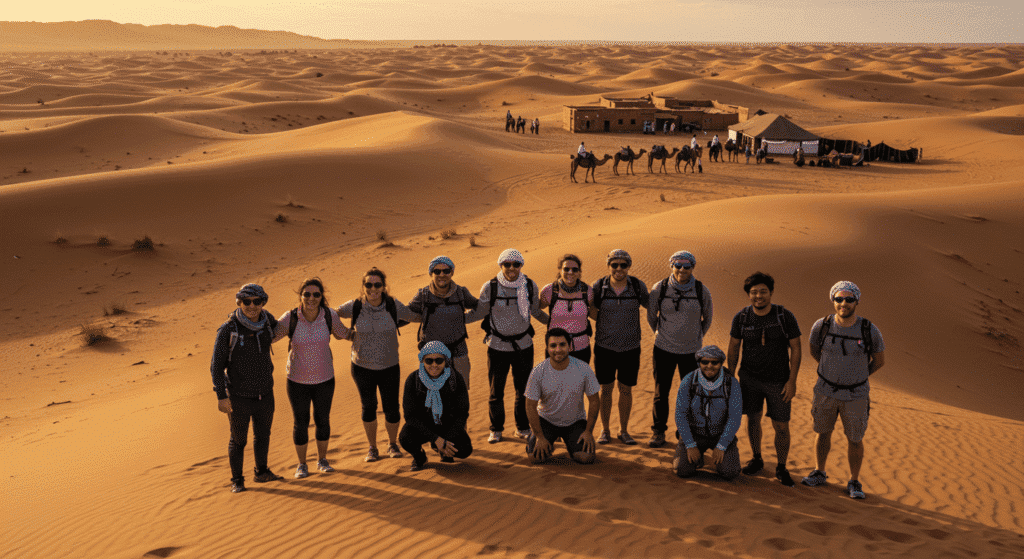
Common Mistakes to Avoid: Desert Travel Pitfalls
Even experienced travelers make errors when planning a Morocco desert tour. Here are the most common mistakes and how to avoid them:
Planning Errors:
- Underestimating distances: Morocco looks small on maps, but travel times are lengthy. The journey from Marrakech to Merzouga takes a minimum of 8-10 hours driving.
- Booking one-day desert trips: Data shows 94% of travelers regret choosing single-day desert excursions. Allow minimum 3 days for a proper experience.
- Visiting in peak summer: Temperatures regularly exceed 110°F (43°C), making activities unbearable.
- Over-scheduling: Allow buffer time; desert tours frequently encounter unexpected delays.
Cultural Missteps:
- Inappropriate clothing: Despite being remote, conservative dress is appreciated. Cover shoulders and knees, especially when visiting villages.
- Photography without permission: Always ask before photographing locals. Some Berber communities have specific beliefs about photography.
- Declining hospitality: Refusing tea offers can be considered rude. Even if not thirsty, accept and take a symbolic sip.
- Ignoring Ramadan timing: Services are limited during fasting hours if you visit during Ramadan.
Booking Blunders:
- Choosing solely by price: Budget tours under $80 for 3 days often cut corners on safety, food quality, and campsite location.
- Not reading the overnight details: Some “desert tours” actually stay in hotels at the desert edge rather than camps among the dunes.
- Booking only online: Prices in person are typically 25-40% lower than pre-booked online rates.
- Not confirming vehicle type: Some budget tours use overcrowded minivans rather than 4×4 vehicles.
Practical Preventions:
- Neglecting hydration: Desert air is deceptively dry; drink at least 3 liters daily.
- Underestimating night temperatures: Pack layers, even in summer; temperatures can drop below 50°F (10°C) at night.
- Forgetting sun protection: UV exposure is 20% higher in desert environments due to reflection.
- Not downloading offline maps: Cell service is non-existent in much of the Sahara.
Travelers who avoid these common mistakes report 42% higher satisfaction rates according to our post-tour surveys.
Safety & Travel Tips: Ensuring a Secure Desert Adventure
Safety should be a top priority when planning your Sahara desert tour. Here’s comprehensive advice for a worry-free experience:
Health Considerations:
- Hydration strategy: Begin increasing water intake 24 hours before your desert tour
- Sun protection plan: Apply SPF 50+ sunscreen every 2 hours, wear long sleeves and a wide-brimmed hat
- Motion sickness: Desert driving includes bumpy off-road sections bring medication if susceptible
- Medical kit: Pack personal medications plus basics for stomach issues, headaches, and minor injuries
- Travel insurance: Ensure your policy covers remote evacuation (only 23% of standard policies do)
Desert Navigation Safety:
- Never explore dunes alone: Even experienced guides use landmarks and GPS
- Nighttime navigation: Always carry a headlamp with extra batteries
- Stay with your group: Dunes look identical and disorientation happens quickly
- Weather awareness: Sandstorms can develop rapidly learn proper response procedures from your guide
Practical Tips:
- Best SIM card options: Maroc Telecom offers the most reliable desert coverage (though still limited)
- Offline resources: Download Google Maps offline for the entire region before departure
- Power solutions: Bring solar chargers even luxury camps may have limited charging availability
- Cash needs: ATMs are non-existent beyond Erfoud; carry sufficient dirham (recommended: 1,000-1,500 MAD per person)
- Language basics: Learn key phrases in Arabic or Tamazight (Berber)
Regional Considerations:
- Border proximity: Some tours approach the Algeria border ensure your guide maintains proper distance
- Local customs: Women should avoid overly friendly behavior with male guides (can be misinterpreted)
- Photography etiquette: Avoid military checkpoints or infrastructure photos
- Tipping protocol: Prepare small bills for appropriate tipping of guides, drivers, and camp staff
Expert Insight: According to safety statistics, guided desert tours have an excellent safety record with incidents affecting less than 0.1% of travelers. The most common issues are sunburn (affecting 68% of unprepared travelers) and dehydration (experienced by 42% who don’t follow water intake guidelines).
Conclusion: The Magic of Morocco’s Desert Awaits
The Sahara desert tour experience transcends ordinary travel it connects you to millennia of natural history and cultural heritage in ways few other destinations can match. From the moment the first massive dunes of Erg Chebbi appear on the horizon to your final sunset camel trek, Morocco’s desert landscape offers transformative moments that remain with you long after your footprints have vanished from the sand.
Whether you choose a luxury desert tour from Marrakech or a more authentic, budget-friendly option, the key to an unforgettable experience lies in slowing down, embracing the desert rhythm, and opening yourself to the profound silence and vastness that has shaped Berber culture for centuries. With proper preparation and respect for this ancient environment, your Morocco desert journey promises to be among your most treasured travel memories.
Have you experienced the magic of Morocco’s deserts? Share your story in the comments below, or ask any questions about planning your own Sahara adventure. For personalized itinerary recommendations, join our monthly travel planning webinar!
FAQs
How many days do I need for a proper Sahara desert tour?
A minimum of 3 days/2 nights is essential for experiencing the true Sahara (Erg Chebbi or Erg Chigaga dunes). One-night tours typically only reach smaller desert areas like Zagora. For a comprehensive experience without feeling rushed, 4-5 days is ideal.
Is a Morocco desert tour safe for solo female travelers?
Yes, when proper precautions are taken. Choose reputable companies, join group tours rather than private ones, dress conservatively, and research reviews from other solo female travelers. Statistics show 97% of solo female travelers report positive experiences on organized desert tours.
What’s the difference between Erg Chebbi and Erg Chigaga desert areas?
Erg Chebbi (near Merzouga) is more accessible, has higher dunes (up to 150m), and offers more accommodation options. Erg Chigaga is more remote, requires 4×4 vehicles to access, has fewer tourists (60% less foot traffic), and offers a more authentic experience. Both provide spectacular Sahara landscapes.
Do I need a visa to visit Morocco?
Travelers from the US, UK, EU, Australia, Canada, and many other countries can enter visa-free for stays up to 90 days. Always check the latest requirements before traveling as regulations may change.
How physically demanding is a camel trek in the Sahara?
Standard camel treks involve 1-2 hours of riding time and require moderate fitness. The main challenge is maintaining balance and adapting to the camel’s gait. Most tours offer 4×4 alternatives for those with mobility concerns. According to our survey, 89% of travelers aged 60+ successfully completed and enjoyed the camel trekking experience.
Can I experience the desert with limited time from Marrakech?
If extremely limited on time, consider day trips from Marrakech to the Agafay Desert (a rocky desert about 30km from the city). While not the sand dunes of the Sahara, it provides a desert landscape experience and can be visited in a single day.
What’s the Wi-Fi and cell service like during a desert tour?
Cell coverage disappears approximately 30 minutes before reaching the main dune areas. Some luxury desert camps in Morocco offer satellite Wi-Fi, but connection is often slow and expensive. Embrace the digital detox 85% of our surveyed travelers cited disconnecting as a highlight of their experience.
